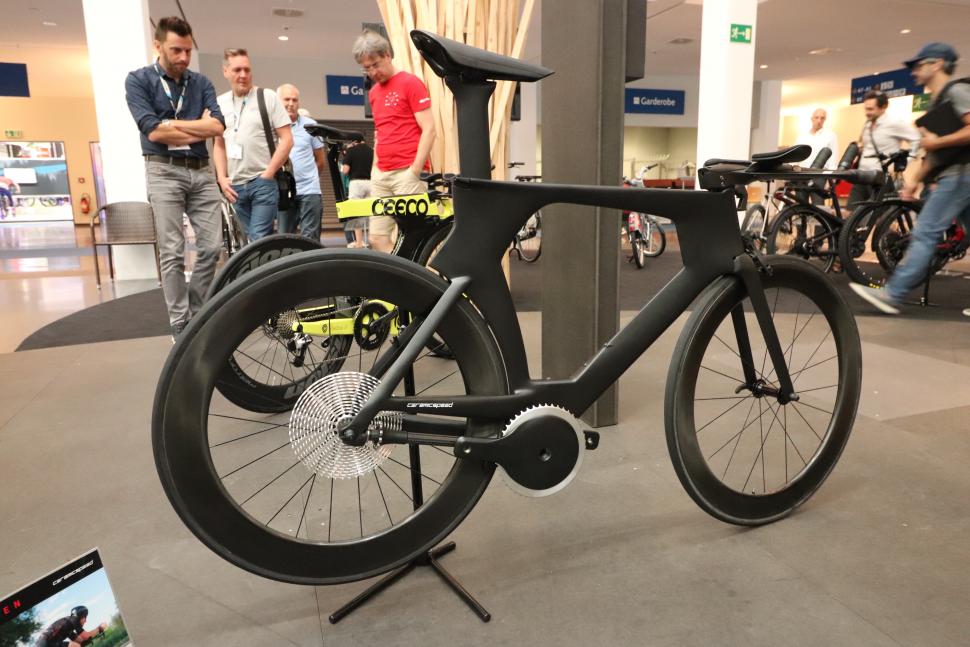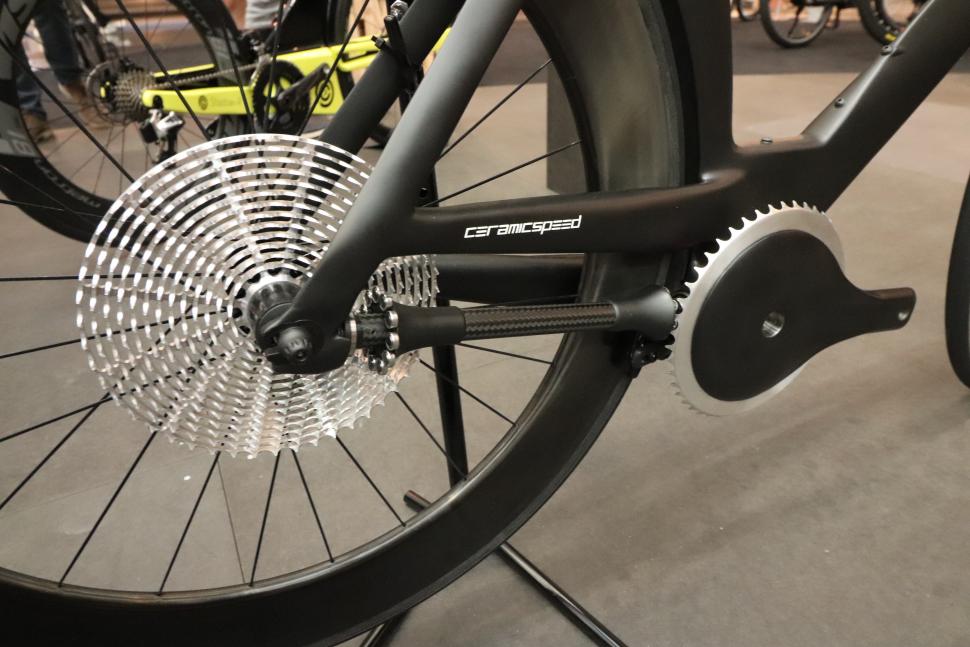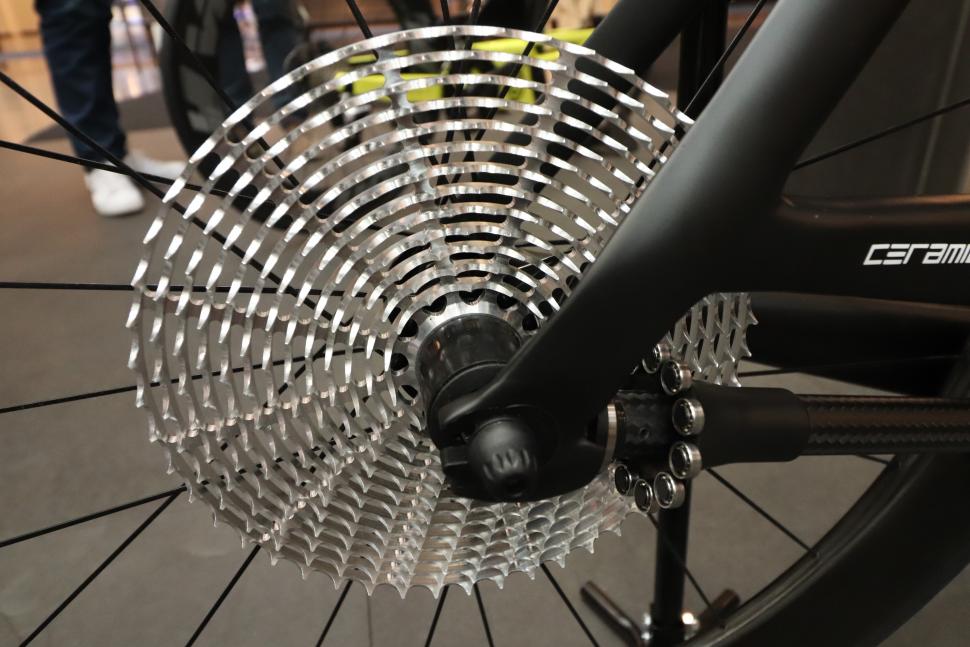- News
- Reviews
- Bikes
- Accessories
- Accessories - misc
- Computer mounts
- Bags
- Bar ends
- Bike bags & cases
- Bottle cages
- Bottles
- Cameras
- Car racks
- Child seats
- Computers
- Glasses
- GPS units
- Helmets
- Lights - front
- Lights - rear
- Lights - sets
- Locks
- Mirrors
- Mudguards
- Racks
- Pumps & CO2 inflators
- Puncture kits
- Reflectives
- Smart watches
- Stands and racks
- Trailers
- Clothing
- Components
- Bar tape & grips
- Bottom brackets
- Brake & gear cables
- Brake & STI levers
- Brake pads & spares
- Brakes
- Cassettes & freewheels
- Chains
- Chainsets & chainrings
- Derailleurs - front
- Derailleurs - rear
- Forks
- Gear levers & shifters
- Groupsets
- Handlebars & extensions
- Headsets
- Hubs
- Inner tubes
- Pedals
- Quick releases & skewers
- Saddles
- Seatposts
- Stems
- Wheels
- Tyres
- Health, fitness and nutrition
- Tools and workshop
- Miscellaneous
- Cross country mountain bikes
- Tubeless valves
- Buyers Guides
- Features
- Forum
- Recommends
- Podcast
TECH NEWS
Video: CeramicSpeed Driven – 99% efficient 13-spd chainless drive shaft concept shown at Eurobike
Who needs a chain? CeramicSpeed doesn't think so, as it used Eurobike to show off its Driven 13-speed pinion drive shaft concept which swaps derailleurs and chains for a drive shaft that it claims provides 49% less friction with a near 99% efficient drivetrain.
We popped a camera in front of Jason Smith, Chief Technology Officer and founder of Friction Facts, who is based out of Boulder in the US and has headed up this project.
What is Driven?
Ceramic Speed is obsessed with maximising drivetrain efficiency, previously through its work with lubes and coated chains. Driven is an attempt to reach the holy grail of a completely efficiency drivetrain. A modern drivetrain is in the region of 90-98% efficient, depending on the conditions of the drivetrain.
Air resistance is the biggest obstacle to going fast, which is why lots of manufacturers have been working on aero bikes, wheels, helmets and clothing. But mechanical drag - friction in the drivetrain - contributes a very small part to the overall drag you face as a cyclist and still leaves a marginal area of potential improvement.
And it’s this small margin that Danish company CeramicSpeed is chasing. It claims the Driven concept is 99% efficient, with 49% less friction than a regular groupset.
How is it so efficient?
It’s all about reducing the points of contact. A regular drivetrain has eight points of sliding friction, Driven eliminates them all completely by using a pinion-style drive shaft system.
There are 21 CeramicSpeed bearings in the system that it claims provides extremely low rolling friction and durability. These bearings transfer torque from the front chainring through the drive shaft onto a 13-speed rear sprocket.
As Jason mentioned in the video, the Drive concept impressed the judges at Eurobike and it won an award for innovation.
“CeramicSpeed has proudly accomplished what many have said couldn’t be done. We achieved a 99% efficient multi-speed drivetrain while eliminating the chain and complex rear derailleur. Advancements in drivetrain technology have been evolutionary since the 1920s. Driven is truly revolutionary given its unique rolling element power transfer and unmatched efficiency. The Driven concept has the ability to change the way the cycling industry views drivetrain design and drivetrain efficiency,” explained Jason Smith.
Drive shafts and chainless bicycles are nothing new in cycling. A quick Google search will provide plenty of evidence of bike companies using chainless drivetrains, mainly for urban and city bikes, and alternative drivetrains have been around since the invention of the bicycle. But the modern derailleur-based drivetrain has been refined and improved over the years and has become the de facto choice for most bikes, from racing bicycles to hire bikes.
CeramicSpeed is focusing on the benefits of this pinion-style drivetrain for performance and racing cyclists, as the photo of the time trial bike clearly demonstrates. It's clearly still at concept stage and there was no indication of when a production version might be available if it ever makes it beyond the concept stage.
What do you think of Driven? Could you see it on your road bike in the future?
David worked on the road.cc tech team from 2012-2020. Previously he was editor of Bikemagic.com and before that staff writer at RCUK. He's a seasoned cyclist of all disciplines, from road to mountain biking, touring to cyclo-cross, he only wishes he had time to ride them all. He's mildly competitive, though he'll never admit it, and is a frequent road racer but is too lazy to do really well. He currently resides in the Cotswolds, and you can now find him over on his own YouTube channel David Arthur - Just Ride Bikes.
Latest Comments
- Muddy Ford 1 sec ago
Disgraceful sentence that reinforces the contempt towards cycling. I hope both the driver and judge suffer a serious illness.
- slc 1 hour 5 min ago
I think it has got better in some locations. For example, Baldwin Street and Victoria Street. Bus gates there have improved conditions greatly for...
- lawrence18uk 8 hours 27 min ago
" in what appears to be two random, completely unprovoked attacks."...
- hawkinspeter 9 hours 19 min ago
You could get away with much less turning area required if you go for a Kakeya set...
- Gbjbanjs 9 hours 31 min ago
Insured yes, through BC, no.
- Gbjbanjs 9 hours 38 min ago
Any chance we could have bike reviews for people with normal disposable incomes? My ti bike cost £2k, brilliant, versatile.....
- matthewn5 10 hours 37 min ago
I built a gravel bike last summer - a Ridley Kanzo Fast with Campag Ekar - and have used it through the winter with mudguards for club runs and the...
- David9694 14 hours 12 min ago
Another Conservative bemused at how but a Conservative policy is turning out
- Global Nomad 19 hours 41 min ago
would be good to see you test the Newmen wheels the weight/price ratio is extremely good and suggests that europeans can match the chinese in this...



Add new comment
27 comments
I'm all for innovation and wish the innovators of this latest shaft drive every success. Failure often precedes correction and negatives are often overcome by positives, as cyclists we should always be looking to be 'moving on'!
A Rohloff speed hub ranges from 95.8% to 99.5% in terms of efficiency. I'd be all about perfecting this technology. Pretty much maintenance-free, and efficient in keeping the rotating mass at the very centre of the wheel. Weighs around 1800g. Any idea on the weight of CeramicSpeed's concept? That drive-shaft isn't featherlight.
There's chat of them saying it's lighter than a similar metal chain driven system - but no details of what precisely the comparison is. Think people also need to bear in mind this is still basically a proof of concept, no-one - least of all CeramicSpeed - is pretending this is a production item.
I really like the idea of hub gearing for some situations but it's never going to work in anything with a nod towards performance with the current technology - not a problem for lots of uses - and it's still unfortunately bloody expensive and heavy.
I'd like to know the figures for the rohloff hub come from and what they measure. I dontbthink there ecists a trans misdion that is 99.t% efficient. You have to remember also that those losses are after the chain losses.
The guy in the video says some very misleading statistics...
At the 1:34 mark in the video... "49% less friction that a conventional drivetrain" When in reality a conventional drivetrain on a bicycle is already one of the most efficient forms of transport there is. Already there's hardly any friction with a conventional derailleur and chain set-up. So 49% of next-to-nothing isnt saving much. Very marginal.
At the 1:42 mark in the video... "This achieves 99% efficency at 380 Watts rider output" When in reality just which riders is this product aimed at??? Because 380W is actually a very high figure! Its way more than my 20 minute max effort. When cycling a decent length route, my weighted power average would be half that. I can only sustain 380W for just under 1 minute.
Pros can't currently use this - UCI regs specify that the rear wheel is driven by a chain.
I just can't see that being as efficient as a chain drive. You change planes twice. That almost inevitably has (relatively) large losses, and then there is sliding interfaces at both pinions, and then losses to the pressure /mating force to prevent the pinion jumping off the sprocket. I can see this being low losses at no /low load but being considerably lower efficiency under load than a chain drive. Any mechanical engineers on here want to take this up?
I can't see that pinion drive shaft being as affordable as a chain. Nice concept though. Perhaps we'll start seeing the pros on these in a few years.
Why only 13 gears? Conceptually you could go all the way out to the rim. Nice to see some genuine innovation.
Looks like one tiny bump and it will never be in alignment again. Chains are not impervious but Froome went arse over tit the other day and got up and rode to the finish. Needs a lot of testing to prove it is worth it.
I would like to see oil impregnated brass bushings instead of ceramic bearings. That way it's cheaper but still quite low friction and quite a bit sturdier.
I think this is awesome! Old school indeed, but very clean and straight forward looking.
Few questions around durability and strength.. but hey, details shmeetails..
An intriguingly clever idea but if disc brakes are allegedly dangerous, what's that massive spinning cheese grater going to do in a crash ???
???
Ha! Yes, it does look like something a Bond villain would deploy.
Given that there is no chain that moves location I would assume that an eventual real product would probably have an aerodynamic guard built in to the front of the design.
As for others taling about alingment, while they didn't show it change gear the geared bike clearly achieves a gear change by sliding the rear planetary gear axially along that shaft.
This is somewhat similar to the system used inside manual car gearboxes which are relatively maintenance free compared with bicycle transmissions. In fact I suspect that such a system would be virtually fool proof to set up and essentially mainenance free.
I suspect the solution to debris will also be dust covers that keep solid objects beyond the size the gears can handle away from the cogs.
They didn't show it change gear mainly because it can't do so yet!
"The CeramicSpeed DrivEn is a concept, and one with several steps to go before becoming a useable product. For starters, there is not yet a way to shift the system, but Smith says a wireless servo could be installed inside the shaft to move it fore and aft on the cassette."
...from Bike Radar.
Looks like a very interesting and elegant solution.
Would it have the robustness not to slip under a Kittel-style sprint power?... there is not a lot of contact between the drive train and the sprocket, compared to a chain wrapped around multiple teeth at either end and spreading the load.
THIS.
All the load is taken through one tooth.
#fail
If chain and sprocket is still good enough for a MotoGP bike, it's still good enough for bicycles.
Personally, I don't think I can put down as much power as a MotoGP so when I lose 1% of my power, it slows me down whereas MotoGP is more constrained by tyres/handling/skill etc.
I doubt you'll notice a 1.5 Watt difference on a bicycle.
If a shaft drive is good enough for a BMW motorbike, it's good enough for a peddle bike.
Obviously shaft drives also work on numerous vehicles with high power and torque.
It's definitly good enough for the very speedy ReadBike, Reading's bike dock system.
Fascinating reworking of an old concept.
I'd love to have a go to see how it feels...and sounds.
As OldRidgeback mentions, I'd also be concerned about durability vs cost - I know ceramic bearings are less sensitive to contaminants, but they can be astronomically expensive.
At this stage though, cost is immaterial.
That certainly looks cool - but I'd be curious how durable it is over time. It's certainly worth more investigation. How much would it cost? Would it just suit road bikes (some grit and stones in the wrong place might make it unsuitable for use on an MTB)?
Fixed?
New meets Old?
Whatever the case, great to see bold ideas experimented upon.
image.jpg